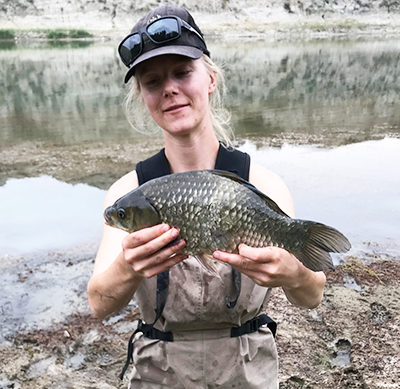
Cait Donadt, a master's student working with Jonathan Ruppert's research team, holds one of the largest examples of a Prussian carp found in Alberta waters, this one approximately 30 cm long.
They look like goldfish, but Prussian carp are an invasive non-native fish species that are capable of rapidly cloning themselves-and a new study shows that they are seriously damaging Alberta rivers.
That's ominous news for all of North America's freshwaters, say researchers in the Department of Renewable Resources who discovered the extent of the harm occurring in 12 rivers and streams within the Red Deer River watershed.
"Prussian carp decrease the abundance of native fish species and change aquatic invertebrate species (the bugs that live in the water)," said Jonathan Ruppert, lead author the study.
"They disrupt the natural structure of these ecosystems," he said. "We need that natural balance because it supports the fundamental process that delivers us such things as clean water and healthy freshwater ecosystems."
Research by Ruppert, supervised by assistant professor Mark Poesch, is the first evidence of precisely how negative an impact Prussian carp is having in North America.
When combined with earlier findings from Poesch's lab, which showed that Prussian carp exist in southern Alberta, just 200 km from the Missouri River drainage, it is extremely concerning.
"The Missouri River drainage is connected to the Mississippi River," said Ruppert. "Given the canal systems in that part of the province, there is a high-risk potential for Prussian carp to disperse to this system and then to spread throughout North America."
Once invasive species are entrenched they are very difficult to eradicate, said Poesch.
"And there's some research elsewhere that says it makes the whole ecosystem more susceptible to other invasive species," he said.
Prussian carp dominate and choke out native species of fish for several reasons. They can survive extreme environmental conditions, such as low oxygen levels or high amounts of algae. They are also able to reproduce asexually, using the sperm of related species, which interferes with native species spawning.
They were first documented in Alberta in 2000, and in Saskatchewan in 2006, but it is still unclear to researchers in Canada or the U.S. how they arrived in North America from Europe around the beginning of the millennium.
Now that there's proof of how damaging they are being in Alberta, it's important to educate both recreational fishers and non-fishers about them, said Poesch.
Since Prussian carp are almost indistinguishable from goldfish (although they can grow as long as 30 cm) it may be that they are unwittingly being transferred to new waters for bait or fishing stock by humans who have misidentified them, he said.
Poesch's next step is to develop an environmental DNA test, which would allow fisheries managers to easily tell whether there are Prussian carp in a body of water simply by sampling the water, in lieu of the more time-consuming method of catching the fish.
The study is published in the journal Royal Society Open Science.